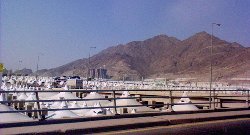Physical activity and ritual highlights of Hajj
Kinesiology is a word I want to introduce here. It is the study of the mechanics of motion as this relates to human anatomy. That is what we want to consider as we review the routine and ritual activities, and the prevailing human and topographical conditions, involved in making Hajj.
The Succession of Rites and Good Sense Prescriptions
1. Tawaaf (the seven circumbulations of the Ka`bah):
The distance it takes and speed at which you go around the Ka’bah will vary depending upon your proximity to it. In the company of millions, that variance can be huge. It's not only a matter of how far you are horizontally from the Ka’bah, but what floor you’ve chosen to make tawaf on. Many people love to make additional voluntary revolutions after completing the mandatory number.
Prescription: Make your Tawaaf a comfortable, slow pace. Adjust your plan of Tawaaf to an area or floor where the crowd flows to your liking, if possible. This is much safer because usually it is the crowd that dictates the speed. If you're a particular slow mover or have someone elderly or with disability in your company, choose a time of day and place where the traffic is relatively lighter.
2. Sa’y: (the seven passes between):
Mount Safa and Marwah stand a short distance from the Ka`bah and roughly a half mile (800 meters) apart. The seven passes between them, emulating the steps of our mother Hajar, include four passes from Mounts Safa to Marwah and three from Mounts Marwah to Safa. That’s a total linear distance of 3.5 miles. So be ready. Unlike Tawaaf, Sa’y requires a faster paced walking, interspersed with jogging between green lights set overhead, for that is what Hajar did, in search of water or help for her baby Ismaa‘eel. For the physically fit, this will be only of moderate intensity, in terms of exertion. For the unfit, it is a more severe challenge. There is not much incline to worry about. The traverse has been tiled over evenly and the to-and-fro lanes are separated.
Prescription: Prepare for your Sa’y by beginning a good daily walking regimen at least two months in advance, if your condition permits. Try to at least approximate its distances. A little interspersed jogging is even better, if you are able. For those who are elderly or unable, there is an intermediate lane between the to-and-fro traverses that is wheel chair and litter accessible. If this will be your choice, assign obligations and prepare for it in advance. Consult those who have been there and who know.
3. On the way to Mina:
Mina is the place of encampment in Hajj. Departure to Mina is normally from near the Haram, and the standard transportation mode is air conditioned buses, though thousands walk. Usually there is no time constraint. But the combined affects of over crowding tension, temperature, and pollution can be dangerously over-whelming for the vulnerable. Those walking could experience significant physical exhaustion with all the expo-sure, particularly since the crowds and carrying personal effects could turn the five mile trek into a journey of several hours.
Prescription: Arrange for an air-conditioned bus with your Hajj package, especially if you know your physical circumstances would make walking or other modes of travel overwhelming. Understand that even the mere embarking on the bus can be confusing in such crowds and may expose you to the outside elements much longer than you think. Drink plenty of water, plan medicines accordingly, and pre-pare to be patient through potential frustrations.
4. In 'Arafah and Mina:
'Arafah is about 2.5 miles (4 km) from Mina. Again because of heavy traffic it may take several hours to travel that distance. The weather in 'Arafah is dry and hot. It is not as easy to find one’s way around as you might at first think. If you depart, go with a guide. Take water. Many people suffer heat sicknesses and disorientation, getting lost after separating from their appointed group, most often to climb the famed Jabal Ar-Rahmah. Departure to Muzdalifah after 'Asr comes amazingly fast. The night in Muzdalifah usually passes quickly under the open sky. Adverse weather changes are uncommon. Coolness can come as a surprise blessing, but this is rare.
Prescription: Adverse weather effects can be avoided if precautions are taken. If you depart from your tent and group, go with a guide. Take sufficient water. If you get lost, look for one of the many aid facilities.
5. Back to Mina, the Jamaraat, sacrifice and Tawaaf al-Ifaadah (Az-Ziyarah):
The stay in Mina is generally relaxed. Throwing pebbles at the three Jamraat, however, has been associated with many difficulties and injuries because of the carelessness of the crowds. Unless done carefully, the pelting could be harmful to others.
Prescription: Stone the Jamraat at appropriate times. Do not be in a hurry. Stay away from the irresponsible pushers and shoves, who sometimes form themselves into human gauntlets out of ignorance. Do not get too close to the Jamraat, or pebbles will inevitably hit you. If you do get hit by accident, do not turn around and expose your face and eyes to risk. Take care on the upper levels not to place yourself too near the short walls. The infirm and elderly can appoint others to perform this task, if needed, and may depart Mina early, under the right conditions. Tawaaf Al-Ifaadhah, Farwell Circumambulation at the Ka `bah, can be done any time during the days of Tashreeq.
6. Days of Tashreeq
These are the recommended days of extended stay after completing the obligatory rites of Hajj, usually three (but may be longer). These are the days of feasting after sacrifice. This generates an enormous amount of ground and air pollution, putting a severe strain on the local authorities to maintain a healthy sanitary environment. It is, therefore, the time to be vigilant about hygiene.
Prescription: Be careful about what you eat, and from where you drink. Excessive hand washing is recommended, especially after any hand shaking or human contact. There is plenty of greeting and congratulating going on. The whether can be particularly hot and uncomfortable, so find places to rest with good ventilation. Be vigilant about utensil use and keep an eye on cooking apparatus and flames. Fire can catch and spread quickly in the sometimes high winds.
A Word on acclimatizing
The body needs one to two weeks to get used to extreme heat, which it does by a gradual increase in its capacity for sweat production. No one can acclimate to acute exposure to extreme heat. In this situation, the body temperature will quickly rise because of a lack of sweat production and serious heat illness (stroke or exhaustion) becomes inevitable when sweat production fails. Heat stroke can be fatal.
Similarly, the body cannot quickly adapt to hyper-exposure to extreme cold. The body tries to produce extra heat to maintain the core temperature by muscle contraction, or shivering. That’s a sign to get to warmth.


 Home
Home Discover Islam
Discover Islam Quran Recitations
Quran Recitations Lectures
Lectures
 Fatwa
Fatwa Articles
Articles Fiqh
Fiqh E-Books
E-Books Boys & Girls
Boys & Girls  Hajj Rulings
Hajj Rulings Hajj Fatwas
Hajj Fatwas














